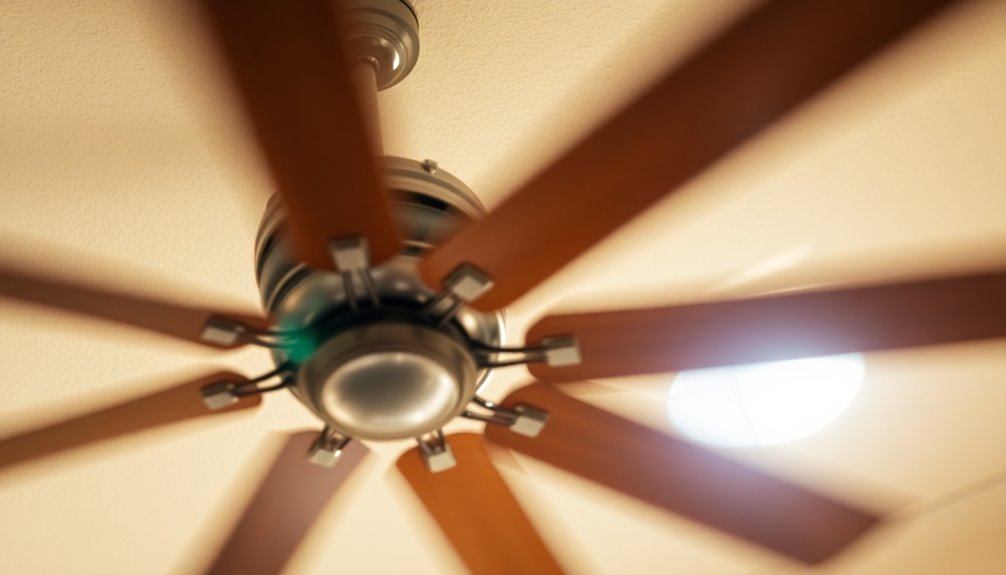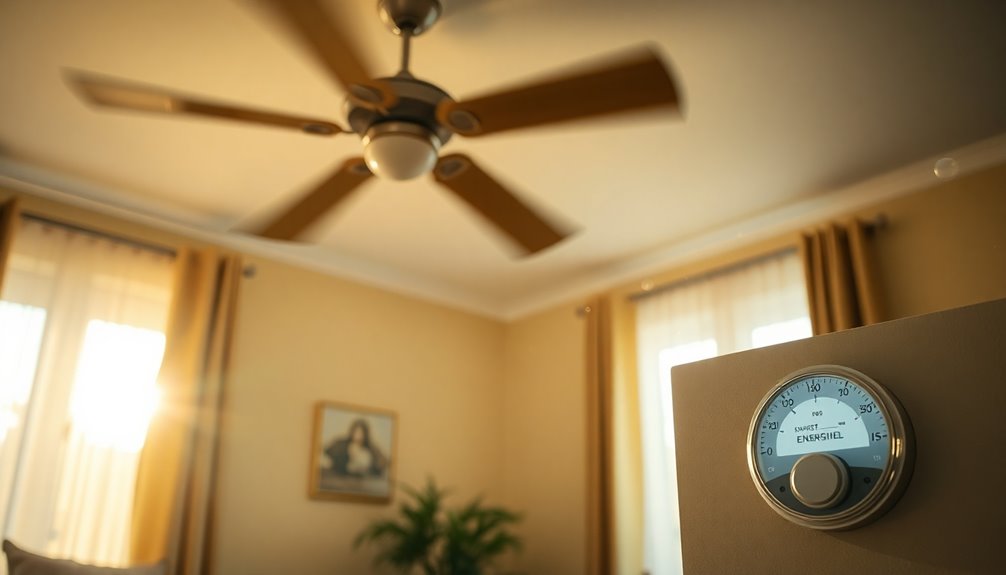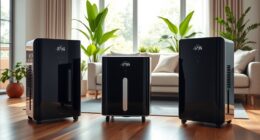If your ceiling fan isn't blowing air, it could be due to several factors. First, check the fan's rotation; it should spin counterclockwise for cooling. Also, make certain the blades are the right size and in good condition. A tilted base or improper installation height can obstruct airflow, so verify the fan is level and properly installed. Don't forget about electrical issues, like blown fuses or loose wiring, which can stop the fan from working. By addressing these common problems, you can restore airflow while learning more ways to enhance your fan's performance.
Key Takeaways
- Ensure the fan is set to rotate counterclockwise for summer cooling, as incorrect direction can hinder airflow.
- Check the blade size and condition; smaller or damaged blades can reduce airflow efficiency.
- Verify that the fan is installed at least 2.1 meters from the floor for optimal performance.
- Inspect electrical connections for looseness or damage, as faulty wiring can disrupt power supply.
- Look for obstructions around the fan, as blockages can prevent effective air circulation.
Incorrect Fan Rotation Direction

One common reason your ceiling fan mightn't be blowing air effectively is its rotation direction. If the fan blades are rotating in the incorrect fan rotation direction, you won't get the cooling effect you expect during the summer months.
Ceiling fans can spin either counterclockwise or clockwise, and for maximum airflow, you need to verify it's set to counterclockwise during hot weather. This rotation pushes cool air downwards, creating a revitalizing breeze that enhances your comfort.
To check if your fan is rotating correctly, look for the reverse switch on the motor housing. It's vital to verify this setting, especially after seasonal changes or maintenance.
If your fan is still operational but feels stagnant, it's likely due to incorrect fan rotation direction, leading to airflow issues. You might think the fan isn't working well, but it could simply be the blades are set to push air upwards instead of downwards.
Fan Blade Size Issues

If your ceiling fan isn't providing the cooling relief you expect, the size of the fan blades could be a considerable factor. The ideal fan blade size typically ranges from 48 to 60 inches for peak airflow effectiveness.
If your ceiling fan has smaller blades, around 30 inches, they mightn't produce sufficient airflow, leaving your space feeling warm and stagnant. Conversely, larger blades can create excessive wind resistance, which may hinder the fan's performance and ultimately reduce airflow effectiveness.
When it comes to replacing blades, make sure you choose ones that match your fan's specifications. Unscrewing the old blades and sliding in the new ones can help restore proper operation.
Additionally, consider the design and pitch angle of the blades, as these elements greatly influence how air circulates in the room. A well-designed blade with the right pitch can enhance airflow dynamics, making your fan work more efficiently.
To summarize, evaluating the fan blade size and confirming it's appropriate for your ceiling fan will greatly impact your fan's ability to circulate air effectively.
Tilted Base Problems

A tilted base can greatly hinder your ceiling fan's performance, leading to poor airflow and increased frustration.
When the base isn't level, it disrupts the proper rotation of the fan blades, ultimately affecting the air blowing throughout your space. This issue often arises from uneven surfaces or improper installation.
To resolve tilted base problems, consider the following steps:
- Check for uneven surfaces: Inspect the mounting area to verify it's flat and stable.
- Tighten hanger bracket screws: Secure the screws to level the fan's base, which will help improve airflow.
- Reattach the canopy: After adjustments, make sure to reattach the canopy to maintain aesthetics and prevent future misalignment.
- Regular maintenance: Routinely check the installation for levelness to catch tilt-related issues before they worsen.
Improper Installation Height

Installing your ceiling fan at the wrong height can seriously throw off its performance. According to the Australian Standard AS 4226 – 2008, your fan should have a minimum clearance of 2.1 meters from the floor for maximum airflow. If it's too close to the ceiling, airflow gets restricted, leading to poor circulation and reduced cooling efficiency.
Here's a simple breakdown of fan types based on installation height:
| Fan Type | Ideal Height |
|---|---|
| Standard Fan | 2.1 meters or more |
| Ceiling Hugger Fan | Less than 2.4 meters |
If your fan's installation height doesn't comply with these guidelines, you might need to make adjustments. This could mean using longer downrods or opting for a ceiling hugger model designed for low ceilings, typically under 8 feet. Remember, proper installation height not only enhances airflow effectiveness but also guarantees safety. Fans too close to the ceiling risk overheating or mechanical failure, so be sure to check your fan's height and make the necessary changes for the best performance.
Electrical Issues

Even when your ceiling fan seems to be functioning, underlying electrical issues can prevent it from blowing air effectively. If you notice a lack of airflow, consider the following potential electrical problems:
- Blown Fuses or Circuit Breakers: Check your electrical panel for blown fuses or tripped breakers that might be affecting your fan's power supply.
- Loose Wiring: Inspect the wiring connections for any loose or damaged wires, as this can disrupt the flow of electricity to the fan motor.
- Faulty Capacitor: A malfunctioning dual or single capacitor can hinder your fan's performance, preventing it from spinning at the necessary speed for effective air circulation.
- Defective Fan Motor: If the fan motor is defective, it won't be able to spin the blades properly, leading to minimal or no air movement.
If you suspect any electrical issues, it's best to consult a professional electrician. They can safely diagnose and address the problem, ensuring your ceiling fan operates as intended.
Don't overlook these electrical problems, as they could be the reason your fan isn't delivering the airflow you need.
Maintenance and Cleaning Tips

Regularly maintaining your ceiling fan is vital for guaranteeing it operates efficiently and effectively. Start with cleaning the fan blades using a damp cloth to remove dust and debris. Accumulated dirt can hinder airflow and decrease performance, so make this a routine task. Additionally, regular maintenance can prevent dangerous situations related to mechanical failures. Furthermore, keeping your fan clean can enhance its energy efficiency, allowing it to operate more effectively while using less power.
Next, inspect the fan's motor and wiring connections. Look for any signs of wear and tear, making sure everything is secure and free from obstruction. This step is significant for maintaining peak functionality.
You should also check for obstructions around the fan, like light fixtures or hanging decor, which can impede airflow and affect overall performance.
Don't forget to schedule periodic professional maintenance. This guarantees all components are functioning correctly and helps identify any mechanical issues before they worsen.
Finally, pay attention to any unusual sounds during operation. These noises may signal mechanical problems that require immediate attention. Additionally, ensuring that the fan is free from accumulated dust and debris can significantly improve airflow and efficiency.
Troubleshooting Steps to Follow

If your ceiling fan isn't blowing air, start by checking its rotation direction; it should spin counterclockwise for cooling.
Next, inspect the electrical connections to make certain everything's secure and working properly.
Finally, examine the condition of the blades to guarantee they're free of dust and damage, allowing for ideal airflow.
Check Rotation Direction
Sometimes, the direction your ceiling fan is spinning can make all the difference in airflow. If your fan isn't blowing air effectively, it might be time to check its rotation direction. Here are some steps you can follow:
- Locate the Direction Switch: Find the fan's direction switch on the motor housing. Make sure it's set to counterclockwise for summer cooling. This rotation direction pushes air downwards, creating that invigorating wind chill effect.
- Observe the Spin: If the fan spins clockwise, it may pull air upwards, leading to a lack of airflow in the room. Adjust it to counterclockwise for better air blowing.
- Check Blade Pitch: The angle of the fan blades can impact how effectively it circulates air. Verify they're positioned correctly for peak performance.
- Seasonal Adjustments: Remember to switch the fan's direction with the changing seasons. Use counterclockwise for summer and clockwise for winter to enhance comfort levels.
If you still experience airflow issues after adjusting the rotation direction, further troubleshooting may be needed.
Inspect Electrical Connections
Before diving deeper into troubleshooting, it's essential to check the electrical connections of your ceiling fan. Loose or insecure wiring can prevent the fan from receiving adequate power, which means the fan isn't blowing air as it should. Start by inspecting all visible connections to confirm they're tight and secure.
Next, look for any signs of wear, damage, or fraying on the wires. Such issues can lead to electrical shorts and connectivity problems. Don't forget to check the fan's pull chain or wall switch too; if these controls aren't functioning correctly, they can disrupt the power supply to the fan.
Also, verify that the circuit breaker for the fan hasn't tripped. A tripped breaker cuts off power, stopping the airflow completely.
If everything seems in order but the fan still isn't operational, it might be time to think about consulting a professional electrician. They can inspect internal wiring and electrical components, like capacitors, to confirm everything is working effectively.
Examine Blade Condition
While your ceiling fan might seem to be in good condition, examining the blades is essential for peak performance. The blade condition directly impacts airflow and overall efficiency.
Here are some steps you should follow:
- Inspect for Damage: Check the blades for any chips or cracks. Damage can disrupt airflow efficiency and cause vibrations, making your fan less effective.
- Secure Attachment: Confirm the blades are securely attached to the motor. Loose blades can wobble, which limits their ability to move air effectively.
- Regular Cleaning: Clean the blades regularly to remove dust and dirt buildup. This grime can hinder airflow and reduce the fan's performance.
- Check Alignment: Verify that the blades are properly aligned. Misaligned blades can lead to uneven airflow, making your fan work harder to cool the room.
User Experiences and Solutions

Many users have faced the frustrating issue of their ceiling fan not blowing air effectively, leading them to share various solutions that worked for them. Here's a summary of their experiences:
| Issue | Solution | User Feedback |
|---|---|---|
| Fan direction incorrect | Change the direction setting to downwards | "This made a huge difference!" |
| Worn-out capacitor | Replace the capacitor | "Airflow was restored immediately." |
| Loose screws | Tighten screws and level the fan base | "No more vibrations, better airflow!" |
| Blade resistance | Experiment with blade configuration | "Removing a few blades helped!" |
| Electrical issues | Check wiring and motor condition | "Fixing loose wiring fixed my fan!" |
Frequently Asked Questions
Why Is My Ceiling Fan Running but No Air?
If your ceiling fan's running but isn't blowing any air, check a few things.
First, verify the blades are rotating in the correct direction; you can switch that easily.
Also, consider the blade size—smaller blades can limit airflow.
Make sure the fan's installed at the right height and that the base is level.
Finally, inspect for any electrical issues that might be affecting performance.
A quick check could solve the problem!
Why Is My Fan Turning but Not Blowing Air?
If your fan's turning but not blowing air, check a few key factors.
First, make certain the blade rotation direction is correct; there's usually a switch on the motor housing for this.
Next, verify that the blades are large enough to generate airflow.
Don't forget to inspect for any obstructions or dirt buildup on the blades, as these can hinder performance.
Finally, check for electrical issues that might be affecting its operation.
Why Is My Ceiling Vent Not Blowing Air?
You might feel like your ceiling vent has turned into a decorative feature rather than a functional air source!
If it's not blowing air, check for a closed or blocked damper first.
It could also be that your ductwork's got leaks or poor insulation, making airflow a challenge.
Finally, don't forget about your HVAC system—it might need a little TLC to get everything circulating smoothly again.
How Can I Improve the Airflow in My Ceiling Fan?
To improve the airflow in your ceiling fan, start by ensuring the blades are the right size, ideally between 48 to 60 inches.
Check that the fan rotates counterclockwise for summer cooling. Make sure it's level and securely mounted to avoid tilting.
Keep the blades at least 2.1 meters above the floor, and regularly clean them to remove dust and debris.
Inspect for any obstructions or loose wiring that could hinder performance.
Conclusion
If your ceiling fan isn't blowing air, you're not alone—about 30% of homeowners experience this issue at some point. By checking the fan rotation direction, ensuring proper installation height, and keeping up with maintenance, you can easily improve airflow. Don't forget to troubleshoot any electrical problems, too. With a little attention, you can enjoy a cool breeze once again. So, take these tips to heart and get your fan back in shape!









